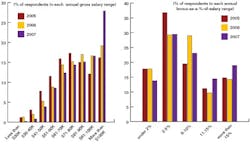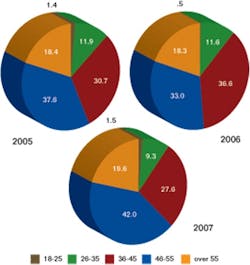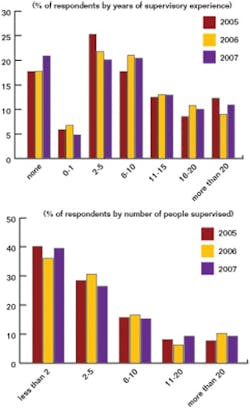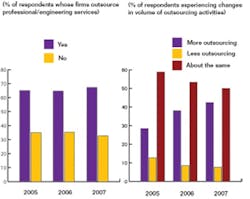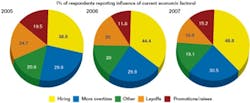However, while higher overall salaries may mean increased pay for some, they may also indicate an older, more experienced pool of respondents.
The 2007 survey’s negative results were that control engineers and their colleagues are earning less overtime, and that their firms are continuing to increase outsourcing. Though it doesn’t indicate an economic downturn yet, 2007’s respondents also are receiving slightly fewer employment benefits in many categories.
Salaries Shifting
The 691 respondents to 2007’s e-mailed salary survey reported a huge jump in their numbers only in the highest salary category compared to the year before (See Figure 1 below). Basically, respondents earning salaries above $100,000 increased to 27.9% in 2007 from 19.2% in 2006, while those in every pay range below this decreased slightly. Meanwhile, those receiving bonuses of 11-15% of their salaries or more than 15% increased almost five percentage points each.
Similarly, while those receiving four weeks of vacation increased to 30.6% in 2007 from 28.2% in 2006 and those taking more than a month off per year jumped to 28% in 2007 from 24.6% in 2006, those receiving three weeks decreased to 27.3% in 2007 from 33.2% in 2006 (See Figure 2 below).
FIGURE 2: MIDDLE AGE GETTING OLDER(% of respondents in each age range)Likewise, slightly fewer of 2007’s respondents reported receiving many of the standard-issue benefits than the year before. These small declines occurred in medical and dental insurance coverage, life insurance, disability, tuition reimbursement, pension plans, profit sharing, and company cars. Slight increases were reported by those participating in 401k plans, flex time, stock options, and telecommuting.
Demographic Constants
As usual—though hopefully not eternally—process control engineers remain overwhelmingly white, male, U.S. residents, who are married with children. However, a five-point decline occurred among respondents identifying themselves as married, down to 85.5% in 2007 from 90.5% in 2006.
Though respondents with four-year undergraduate degrees also remained pretty much constant at 54.1% in 2007 from 53.2% in 2006, the most prevalent academic category again shifted back to “other, mostly mechanical engineering” at 37.1% in 2007 from electrical engineering at 38.3% in 2006 and “other, mechanical” at 36.3% in 2005. The next most popular area of study, chemical engineering, increased to 20.4% in 2007 from 18.4% in 2006.
Meanwhile, those in the “engineering, design, and construction” job category increased to 45% in 2007 from 38.1% in 2006, while those in both the “production and plant operations” and “plant maintenance” categories” increased in 2007 to just over 22% and 23%, respectively, from 18.5% each in 2006.
|
|
2005 |
2006 |
2007 |
|
Salary |
$71-80K (17.3%) |
more than $100K (19.2%) |
more than $100K (27.9) |
|
Hours per week |
41-60 (78.9%) |
41-60 (81.3%) |
41-60 (80.8%) |
|
Bonus |
yes (61.7%) |
yes (63.4%) |
yes (68.4%) |
|
Paid overtime |
no (73.5%) |
no (73.4%) |
no (78.2%) |
|
Vacation |
three weeks (33.2%) |
three weeks (32.4%) |
four weeks (30.6%) |
|
Job description |
engineering, design, construction (33.1%) |
engineering, design, construction (38.1%) |
engineering, design, construction (45%) |
|
Industry |
chemical (16.2%) |
food and beverage (13.8%) |
chemical (19%) |
|
Years at present firm |
11-20; more than 20 (24.1%) |
11-20 (25.5%) |
11-20 (25.6%); more than 20 (26.8%) |
|
Jobs in career |
two (25%) |
two (27.2%) |
two (23.1%) |
|
Years in control |
11-20 (30.2%) |
11-20 (34.8%) |
11-20 (31.7%) |
|
Education |
four-year undergraduate (48.9%) |
four-year undergraduate (53.2%) |
four-year undergraduate (54.1%) |
|
Degree |
other, mostly mechanical engineering (36.3%) |
electrical engineering (38.3%) |
other, mostly mechanical engineering (37.1%) |
|
Residency |
U.S. (98.3%) |
U.S. (97.4%) |
U.S. (98%) |
|
Gender |
male (94.6%) |
male (94.9%) |
male (93.6%) |
|
Ethnicity |
white (86%) |
white (88.9%) |
white (87.9%) |
|
Marital status |
married (84.6%) |
married (90.5%) |
married (85.5%) |
|
Children |
yes (83.6%) |
yes (84.1%) |
yes (86.3%) |
While the survey’s middle-aged respondents reported being collectively younger last year, their average age snapped back up in 2007. In fact, those aged 46-55 years increased to 42% in 2007 from 33.1% in 2006, while those aged 36-45 years decreased to 27.6% in 2007 from 36.6% in 2006. Once again, respondents 26-35 years old and those over 55 years remained relatively constant at just over 9% and 19%, respectively, though the youngsters decreased two points and the old guys increased one point.
In addition, this middle-aged uptick occurred even though respondents with 11-20 years in process control decreased to 31.7% in 2007 from 34.8% in 2006, while those with more than 30 years experience swelled to 15.8% in 2007 from 10.2% in 2006. However, as might be expected, respondents with two to five years of supervisory experience decreased to 20.1% in 2007 from 21.8% in 2006 (See Figure 3 below), while those who supervise 11-20 people increased to 9.3% in 2007 from 6.3% in 2006.
FIGURE 3: MORE MID-LEVEL SUPERVISINGBig-Picture Economics
Pay hikes for the highest-paid respondents can be attributed to several consistent causes. While many of those in oil, gas, and other petrochemical-based settings continue to benefit from high prices in those industries, increasing use of process control technologies in pharmaceutical, food and beverage, and even hybrid applications also is fueling demand for process engineers. Possibly the most crucial factor, however, is the swelling retirement of many older process control engineers, who aren’t being replaced quickly enough because too few students are pursuing process control and engineering as a career.
In addition, besides the expected technological advances, today’s control and automation engineers must handle continuously reemerging software, increasingly PC-based solutions, different fieldbuses and Ethernet implementations, plant-floor to enterprise integration, and newly networked and wireless devices. These accelerating improvements repeatedly upstage each other, and often trigger subsequent alterations in many jobs.
Consequently, these forces have forced both rookie and veteran engineers to acquire more continuing education to cope with new technologies. In fact, one reason there aren’t enough process control engineers is because even available training can’t keep pace with especially fast-paced technology updates.
More Outsourcing, Less Mergers/Layoffs
Because the former merger-layoff strategy has been replaced by increased outsourcing of many engineering and other professional services, the proportion of firms doing outsourcing has remained relatively constant. For example, just over 67% of 2007’s respondents report outsourcing professional/engineers services, while close to 65% reported outsourcing in 2006 (See Figure 4 below).
For the second straight year, some of the best news in 2007’s salary survey may be respondents’ reports that hiring has increased at their companies to 48.8% in 2007 from 44.4% in 2006.
Likewise, those reporting layoffs again declined to 16.6% in 2007 from 20% in 2006 (See Figure 5 below). These results were accompanied by a decrease in overtime to 30.5% in 2007 from 34% in 2006. Fortunately, promotions and raises reported shot up to 15.2% in 2007 from 11.8% in 2006.
FIGURE 5: MORE HIRING AND PROMOTIONSIn addition, respondents identifying “challenging work” as most important for job satisfaction dropped to almost 41% in 2007 from 44.4% in 2006. However, while 22% in 2007 say appreciation is important for job satisfaction, while 19.9% stated it was most important a year earlier.
In addition, 56.6% reported that they aren’t worried about job security in 2007, which was a slight decrease from the 57.1% reporting that they weren’t worried about job security in 2006.
About the Author

Leaders relevant to this article:


